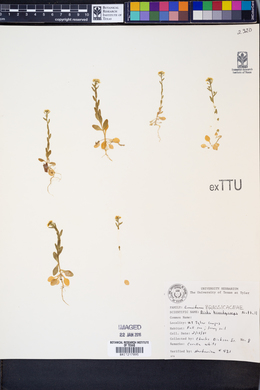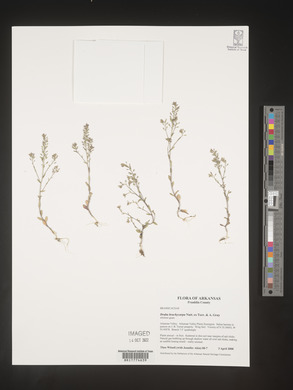Draba brachycarpa
|
|
|
|
Family: Brassicaceae
Short-Pod Whitlow-Grass, more...Smooth Cross-Hair Cress, shortfruited draba, shortpod draba
[Abdra brachycarpa (Nutt.) Greene] |
Annuals; not scapose. Stems usually branched, rarely unbranched, (0.3-)0.4-1.9 (-2.2) dm, pubescent through-out, trichomes sessile, cruciform, 0.2-0.6(-0.8) mm (rays often equal, or those parallel to stem axis longer). Basal leaves not rosulate; petiolate; petiole (to 0.5 cm), not ciliate; blade oblanceolate to obovate, 0.5-2 cm × 2-8 mm, margins entire, surfaces pubescent, trichomes cruciform, 0.2-0.6(-0.8) mm. Cauline leaves (4-)6-11; sessile; blade lanceolate to oblong or linear, margins entire, surfaces pubescent as basal. Racemes (main branch) (20-)25-65(-74)-flowered, ebracteate, elongated in fruit; rachis not flexuous, pubescent as stem. Fruiting pedicels horizontal to divaricate-ascending, straight, (1-)1.5-4(-5) mm, pubescent, trichomes cruciform. Flowers: (late ones cleistogamous, apetalous); sepals (green or pink), oblong, 0.7-1.2(-1.5) mm, pubescent; petals white, spatulate, 2-3 × 0.8-1.1 mm; anthers ovate, 0.15-0.25 mm. Fruits usually elliptic to linear-elliptic, rarely ovate-elliptic, plane, flattened, (2-)2.5-5(-6) × 0.9-1.4(-1.9) mm; valves glabrous; ovules 8-16(-20) per ovary; style 0.05-0.1 mm. Seeds (winged), ovoid, 0.5-0.7 × 0.4-0.5 mm. 2n = 16. Flowering Feb-May. Open woods, cedar glades, pastures and lawns, roadsides, disturbed sites; 0-300 m; Ala., Ariz., Ark., Fla., Ga., Ill., Ind., Kans., Ky., La., Miss., Mo., N.C., Ohio, Okla., Oreg., S.C., Tenn., Tex., Va. Draba brachycarpa is closely related to D. aprica and the two are sometimes confused. It is readily distinguished by having leaves with sessile (versus stalked) trichomes, glabrous (versus pubescent) fruits, and smaller (0.5-0.7 versus 0.9-1.1 mm) seeds. The records from Arizona and Oregon are based on old collections, Porter 802 (Devil´s Canyon, 22 Feb 1926, US) and Howell s.n. (near Cobarg, Willamette Valley, 7 Apr 1887, US); it is not known if these records represent introductions or remnants of a previously wider distribution.
Annual herb with a small taproot to 20 cm tall Stem: single or multiple from base, upright, branched, purplish, with densely appressed forked hairs. Flowers: in a dense, hairy, branched cluster (raceme), which is borne terminally and laterally on a stem. Sepals four, purplish. Petals four or none, upright to spreading, white or yellow, to 3 mm long, to 2 mm wide, rounded or with a slightly notched tip. Stamens six. Fruit: a pod (silicle), 2.5 - 4 mm long, 0.8 - 1.4 mm wide, flattened, oblong-elliptic. Lower leaves: alternate, stalked, egg-shaped, tips rounded to slightly pointed, typically having two small teeth along the margins. Leafstalks to 5 mm long and flattened. The leaves and leafstalks are densely covered with appressed forked hairs like the stem. Upper leaves: alternate, stalkless, becoming lance-shaped to nearly linear, densely hairy. Similar species: Both Draba reptans and D. verna are similar but have leaves confined to the lower (D. reptans) and basal (D. verna) areas. The flowers of D. verna are deeply cleft, and the silicles of D. reptans are more than 5 mm long and 1.3 mm wide. Flowering: March to May Habitat and ecology: Apparently introduced to the Chicago Region from the southern states. Known only from a single collection made in DeKalb County, Illinois, although unconfirmed reports exist. Look for it in lawns, fields, prairies, woods, roadsides, open sandy areas, and along railroads. Occurence in the Chicago region: non-native Etymology: Draba comes from the Greek word drabe (which was also once a Greek word for a cress plant), meaning sharp or acrid, which refers to the burning taste of the leaves. Author: The Morton Arboretum Annual or winter-annual to 2 dm, usually much-branched; basal lvs few and evanescent, elliptic to obovate; cauline lvs narrower, the uppermost nearly linear; racemes all elongate at maturity, 2-6 cm; pedicels ascending, glabrous to minutely stellate, usually 2-3 mm; pet white or yellow, to 3 mm, or none; frs oblong-elliptic, 2.5-4 נ0.8-1.4 mm, glabrous; 2n=16, 24. Dry woods and fields; Va. to Ind. and Kans., s. to Fla. and Tex. Mar.-May. Gleason, Henry A. & Cronquist, Arthur J. 1991. Manual of vascular plants of northeastern United States and adjacent Canada. lxxv + 910 pp. ©The New York Botanical Garden. All rights reserved. Used by permission. From Flora of Indiana (1940) by Charles C. Deam Found locally in dry, sandy soil in woodland pastures and on wooded slopes in a few of our southwestern counties. It has been reported by Nieuwland from Lake, La Porte, and St. Joseph Counties but I could not find specimens from these counties in the herbarium at the University of Notre Dame. Buhl (Amer. Midland Nat. 16: 251. 1935) refers a report by Peattie from the Calumet District to D. reptans. ...... Indiana Coefficient of Conservatism: C = 2 Wetland Indicator Status: n/a |










































































